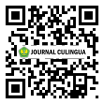THE LEVEL OF THE STUDENTS’ READING COMPREHENSION ANALYZED BY USING BARRETT TAXONOMY
DOI:
https://doi.org/10.37301/culingua.v3i1.110Keywords:
The Level of Reading Comprehension, Narrative text, Barrett TaxonomyAbstract
Students are expected to have strong reading comprehension skills to face the Industrial Revolution 4.0. This article reports the study results on measuring the students' reading comprehension level when reading a narrative text in one of the senior high schools in Padang using Barrett's taxonomy. Two hundred and eighty students of the eleventh grade of the science program were involved in this study. They had learned narrative text in the tenth grade. Eighty students were chosen as the samples using cluster random sampling. They were put into two classes. This is a descriptive quantitative study that uses tests and questionnaires as research instruments. The study results show that the average of the students' scores was 64.525, classified as in the good category. The students were categorized well in responding to questions in the form of appreciation level. This study also discovered that students have difficulties in answering questions from evaluation levels.
References
Arsaf, A. S. (2020). Teaching English In Industrial Revolution 4.0: Challenges and Opportunities.
Asmin, A. I. (2020). Observing the Intellectual Curiosity of English Education Students in the Class. IDEAS: Journal on English Language Teaching and Learning, Linguistics and Literature, 8(1), 46–58. https://doi.org/10.24256/ideas.v8i1.1263
Fahli, N., Mahdum, & Ras. (2015). An Analysis of the Students’ Ability in Comprehending Recount Text at the Second Grade of SMP Muhammadiyah 1 Pekanbaru.
Fitri, F., & Rozimela, Y. (2020). An Analysis of Students’ Reading Comprehension of Analytical Exposition Text in SMA Negeri 2 Batusangkar. Journal of English Language Teaching, 9(2), 405. https://doi.org/10.24036/jelt.v9i2.108613
Gay, L. R., Mills, G., & Airisian, P. W. (2012). Educational Research Competencies for Analysis and Application. Pearson Education.
Ghozali, I. (2018). Educational Challenges to the 4.0 Industrial Revolution: Experience from Indonesia. The International Academic Seminar 2018.
Junika, H. (2018). An Analysis of Students’ Reading Comprehension in Recount Text of Barrett’s Taxonomy of the Eight of SMP Negeri 4 Siak Hulu.
Lase, D. (2019). Education And Industrial Revolution 4.0.
Marzona, Y., & Ikhsan, M. (2019). An Analysis of Students’ Reading Comprehension in Narrative Text at Second Grade At SMAN 1 Talamau. Jurnal Ilmiah Pendidikan Scholastic, 3(1), 35–41. https://doi.org/10.36057/jips.v3i1.349
Noviandi. (2014). An Analysis of Students’ Ability in Comprehending Narrative Text at Grade XI SMA Nurul Ilmi Padangsidimpuan. IAIN Padang sidimpuan.
Sarwo. (2013). Analysis on the Students ’ Problems in Comprehending Narrative Texts. A Research Journal.
Walipah, E., Sopandi, W., & Sujana, A. (2020). Literacy Movement in the Industrial Revolution Era 4.0 in Building Speed Reading Skills. International Conference on Elementary Education, 2(1), 1763–1770.
Zaim, M., Zainil, Y., & Fitrawati. (2021). Reading Assessment to Enhance Critical Thinking, Argumentative Thinking, and Higher Order Thinking Skills in Junior High School. Advances in Social Science, Education and Humanities Research, 142–147.
Zainil, Y., & Lena, M. (2020). Levels of reading comprehension questions in EFL classroom: higher-order thinking skills (HOTS). Proceedings of the Proceedings of the Third Workshop on Multidisciplinary and Its Applications, WMA-3 2019, 11-14 December 2019, Medan, Indonesia, 11–14. EAI. https://doi.org/10.4108/eai.11-12-2019.2290895
Downloads
Published
Issue
Section
License
Copyright (c) 2022 Annisa Krismadayanti, Yetti Zainil

This work is licensed under a Creative Commons Attribution 4.0 International License.









